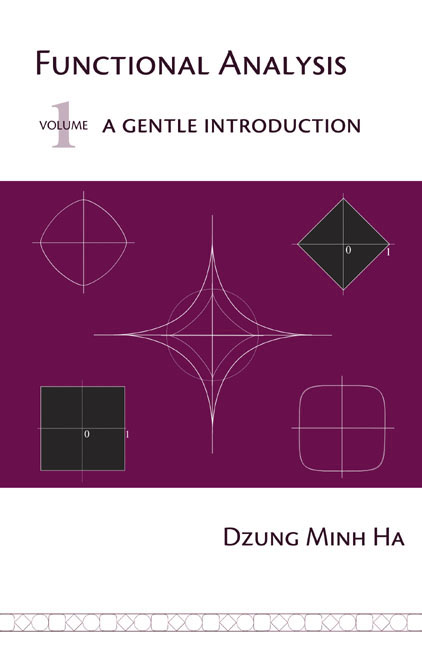 Matrix
Editions
Matrix
Editionsserious mathematics,
written with the reader in mind
 Matrix
Editions
Matrix
Editions
serious mathematics,
written with the reader in mind
by Dzung Minh Ha
 Functional Analysis Volume 1:
A Gentle Introduction
Functional Analysis Volume 1:
A Gentle Introduction
Dzung Minh Ha
640 pages, published in 2006
Reprinted with corrections 2023
Hardcover, smythe-sewn binding
ISBN 9780971576612
Note: you will not be able to print the ebook. Please read this before ordering.
Outstanding Academic Title of 2007
— Choice: Current Reviews for Academic Libraries (See complete review)
Table of
contents (html)
index (in
pdf)
Sample
pages (in pdf)
Preface (html)
Front
cover (designed
by Leila Joiner)
Please consider recommending that your university or department librarian order this book. Thank you!
Student-friendly but rigorous book aimed primarily at third or fourth year undergraduates. The pace is slow but thorough, with an abundance of motivations, examples, and counterexamples. Arguments used within proofs are explicitly cited, with references to where they were first proved. Many examples have solutions that make use of several results or concepts, so that students can see how
various techniques can blend together into one.
Includes solutions to all odd-numbered exercises
This book is designed as an introduction to basic functional analysis at the senior/graduate level.
It has been written in such a way that a well-motivated undergraduate student can follow and appreciate the material without undue difficulties while an advanced graduate student can also find topics of interest: topological vector spaces, Kolmogorov's normability criterion, Tychonov's classification of finite-dimensional Hausdorff topological vector spaces, and the theorems of Korovkin and Muntz, to mention a few.
Textbooks in functional analysis (or more generally, in mathematics) are often unnecessarily demanding -- written in a concise manner with few examples and motivations. Proofs in such textbooks are sometimes so terse that much time and energy are required of students just to verify their logical correctness, let alone understand the ideas behind them. This is counter-productive: students are given the impression that mathematical proofs are mysterious; the proofs fail to convince readers of the validity of the theorems; and students are deprived of an opportunity to learn useful techniques and principles in problem solving.
In contrast, the pace of this book is deliberately slow but thorough.
I chose to write a textbook that I would like to have studied
from as a student - one that is mathematically rigorous but leisurely, with lots of motivations and examples.
This is a student-friendly book that can be read and enjoyed by a reasonably well-motivated undergrad. Proofs are
developed in detail, with all steps justified. Almost all previously proven results used within proofs and solutions to
examples are explicitly cited, and referred to by number. This eliminates unnecessary time and frustration spent figuring
out exactly which results were used and where they were first proved.
See the complete preface.
"The author has set himself a monumental task: writing a functional analysis book that can be read by any well-motivated student, even one with only a modest background in analysis. He carried out this task with great patience and care and he did a
remarkable job....the author has included a great deal of mathe- matics in this book.... all of it is done in complete detail, so a student who is asked to present some topic, in a seminar, say, will find this book a valuable source of information....This is a remarkable book, one that will serve as a valuable reference for anyone." — from SIAM Review, June 2010, Vol 52, No. 2.
"A thorough ... presentation of all the standard topics any introductory functional analysis course might wish to
cover ... highly accessible, self-contained ... Highly recommended." — from the March 2007 issue of Choice: Current Reviews
for Academic Libraries, published by the American Library Association See complete review
"The book contains about 250 examples and counterexamples. It also contains about 800 exercises.... A remarkable feature is an appendix of 120 pages containing the complete solutions to all odd-numbered exercises....
The book is carefully written and its index is well arranged and comprehensive... useful to students
from a wide variety of backgrounds, including graduate students in physics and engineering...." — Zentralblatt Math
"Clearly a labour of love" — Professor C.S. Ramalingam,
Department of Electrical Engineering, Indian Institute of Technology Madras